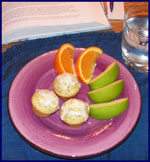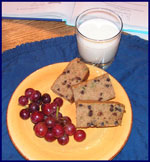Cookin’ at the Keyboard with Shelley
 September means back to school…even for me! This month marks the beginning of our ninth year of home schooling. Sarah, in black, is a junior; Lauren, on the left, is a freshman. The twins, Aundra and Anicia, are in the fourth grade and Megan, our 5-year-old, is proud to be a first grader!
September means back to school…even for me! This month marks the beginning of our ninth year of home schooling. Sarah, in black, is a junior; Lauren, on the left, is a freshman. The twins, Aundra and Anicia, are in the fourth grade and Megan, our 5-year-old, is proud to be a first grader!
Our weekly schedule is full to overflowing. My main focus this year is history, so the dining room table is covered with books, binders, timelines, and coloring pages. I’m also teaching the older girls “how to teach.” The twins take math from Sarah, and Lauren gives them their spelling lesson. Considering that the high school girls are out of the house part of every day for piano lessons or classes at the academy, my first priority has become scheduling (school doesn’t work if the teacher isn’t home!).
Every morning we meet around the breakfast table to review the schedule for the day. It’s much easier to get the girls up and moving if they know that a hot breakfast is waiting for them downstairs. I serve a variety of things, but eggs and muffins bring the biggest smiles. I don’t have room in my freezer for dozens of muffins and baked goods every month, so I’ve created another option. I make my own “baking mixes” to manage both my time and my freezer space.
I use the “cooking day/serving day” strategy discussed below in Software Suggestions. For any baked item (muffins, breads, etc) I combine all the dry ingredients for that recipe and seal in a food saver or freezer bag. After labeling, I toss them in the freezer (if there’s room), or I store them in a cool, dry place. Be sure to date the package.
When I’m fixing breakfast, it’s easy to grab the milk, eggs, oil, and a custom homemade baking mix. I always double (at least) every recipe so that I have enough leftover to put in the freezer for another day. It’s a deep satisfaction to know that my daughters will have memories of waking up to the aroma of fresh baked muffins, at least once in awhile.
In honor of back-to-school, here are two of our favorite after-school snack recipes. Best wishes to your family for a fun and productive school year!
When the zucchini is literally overflowing the garden, we wash, grate, and freeze it. The original recipe didn’t call for chocolate chips, but they turn this snack into a real treat. If you replace half the white flour with whole wheat the kids will never know.
 Glazed Almond Poppy Seed Mini-Muffins
Glazed Almond Poppy Seed Mini-Muffins
This is a special reward for a good day of school. Since these muffins aren’t high on my “healthy snack” list, I use the mini-muffin pan. I recommend glazing them after they’ve thawed, not before freezing. Add some hot tea and “dress up” clothes and you’ve made a memory!
Software Suggestions
“Cooking Day” vs. “Serving Day”
When freezing meals, I have several goals in mind. Primarily, I want to save time, save money, conserve freezer space, serve delicious food, and make it painless to put a meal on the table (I don’t ask for much, do I?) All five of these goals can be accomplished by cooking only part of a recipe.
“Homemade Chili” is a prime example. After frying the ground beef and onion, I stir in all six of the seasonings and freeze in a food saver bag. Time is saved because I prepare multiple quantities of the recipe while the time-consuming task of chopping onion, frying meat, hunting for seasonings, and washing the pans and utensils need to be done only once. Money is saved because the canned tomatoes and kidney beans aren’t purchased until I serve the meal, or until they’re on sale at the store. Freezer space is conserved because I’m storing only the meat, not the tomatoes and beans. My chili is delicious because I’ve cooked the portion of the recipe that, in my opinion, freezes the best. Finally, it’s easy to put the meal on the table; the cooked ground beef thaws quickly and the cans of tomatoes and beans are simple to add.
Believe it or not, it gets even better! Advantage Cooking actually helps me keep track of what I call a S.A.N.E recipe (Some Assembly Needed Eventually). For any ingredient in a recipe, set the “use on” field to indicate whether this particular ingredient is a “cooking day” or “serving day” item. Serving day ingredients are marked with an asterisk* on the printed recipe. I like to use the Move Ingredient buttons to position the “cooking day” ingredients at the top of the recipe and the “serving day” ingredients below.
In addition, three options are available for the Grocery Report. For any group of recipes selected, the grocery list can include:
- all ingredients,
- “cooking day” ingredients only, or
- “serving day” ingredients only.
I use the first option if I want to grocery shop once and make sure that every ingredient will be in the house when I need it. When money is a consideration, I buy the “cooking day” ingredients only, in order to cut down on cost.
To make sure you have all the serving day ingredients on hand, you have two options. Either use the “serving day” option for the grocery report, or print the Recipe Inventory Report. It’s the most convenient because it lists the serving day ingredients for every recipe selected for a cooking day. Print a report and see how easy it is to use!
Closing Comments from Shelley
I manage my kitchen in different ways, based on the season of the year and the season of life. No matter which “season” you find yourself in, I hope I’ve given you some ideas on how to make your kitchen more efficient, for the benefit of your health and your family. Cook on!
Shelley

Sorry, the comment form is closed at this time.